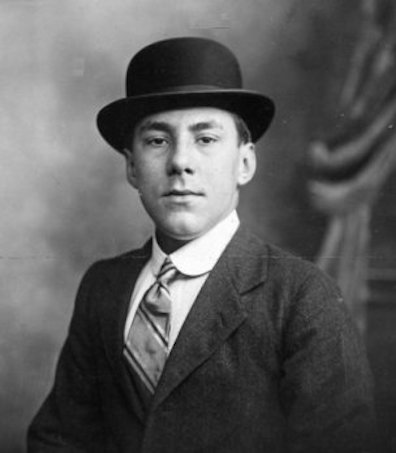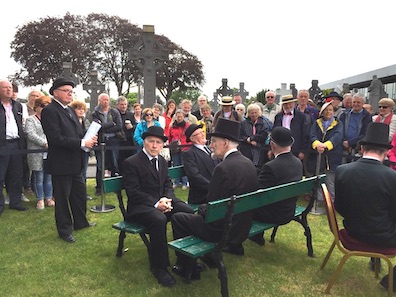People did not go out in public without head coverings in
1904, and the novel mentions many types of men's hats: the silk
top hat favored by the upper classes, worn by Martin
Cunningham, Father Conmee, Professor Maginni, and others; the
jaunty straw
boater worn by Blazes Boylan on June 16 and Bloom on the
day he proposed to Molly on Howth Head; Buck Mulligan's
similarly jaunty panama; Stephen's wide soft Paris
student hat, expressive of bohemian nonconformity; the
flat cap worn by menial workers, boys, and men at leisure
(Bloom imagines buying a nice tweed one to wear while
gardening in his suburban Flowerville paradise); Lenehan's
"yachting cap" (Joyce himself wore one of these as a young
man); the vaguely military uniform caps worn by porters; and
the "peaked cap" or "peak cap" that likewise imitated military
headgear. Probably a few Dubliners sported fedoras or homburgs
in 1904, and then there were unclassifiable creations like the
"small felt hat" worn by Davy Stephens. (Women's
hat styles too receive many mentions in Ulysses,
starting with the daringly mannish tam that Bloom has given Milly for
her birthday.)
Clearly there was a lot of variety in Dublin headgear, but
one type of men's hat would have stood out as prevalent,
respectable, self-effacing, normative. The bowler, a hard felt
hat with a rounded crown, typically black, was invented in
1849 by London hat-makers Thomas and William Bowler for Thomas
Coke, the first earl of Leicester. Coke wanted a hat which,
unlike the top hats of the early 19th century, could protect
the heads of his gamekeepers and not be knocked off by
branches as they rode. The design caught on widely with
working men, as it offered some protection at a time when
construction-zone hard hats did not yet exist. In America it
was called the derby, and it covered the heads of many of the
rough men of the Wild West as well as those of city-dwellers
in the east.
At some point, people in the UK began to regard the bowler as
a status symbol. A page on www.photodetective.co.uk observes
that "In group photographs of workmen, the man wearing the
bowler is the foreman. If you went on to a construction site
the site manager would be wearing a bowler hat. He wore it for
that reason. In the office world a 'bowler' said 'I am in
middle management, I am not hourly paid; I am on a salary.' In
the factory or workplace a bowler said 'I am the person in
charge'." In early 20th century London, countless bankers and
other professional office workers went to work in the morning
with bowlers on their heads, umbrellas and newspapers tucked
under their arms.
Bloom's thoughts in Lotus Eaters show that he wears
this dull badge of belonging not for comfort or style but
because of the impression it makes. Sitting down in one of the
pews in St. Andrew's church, he complains about the bowler's
rigidity and lack of accommodation to the individual skull:
"He approached a bench and seated himself in its corner, nursing
his hat and newspaper. These pots we have to wear.
We ought to have hats modelled on our heads." Only after
readers recognize that "pots" must refer to the unlovely
symmetry of the bowler may they discover that Joyce, earlier
in the same chapter, has studded his prose with a sly verbal
echo of that object. When Bloom retrieves a business card
standing in front of the post office, "His right hand came
down into the bowl of his hat." This is one of Lotus
Eaters' many evocations of tubs,
pots, bowls, fonts, chalices, basins, troughs, wombs,
feedbags, and other receptacles. It is also a blaring clue to
the style of Bloom's hat.
Most people who know anything about Ulysses, if
quizzed, would say that Bloom wears a bowler, but if they were
quizzed about how they know it most would respond with a blank
stare. One source of this widespread unexamined assumption
probably can be found in the little pencil sketch of Bloom
that Joyce made in 1926, but the novel never names the style.
Instead, Joyce subtly invited the inference with "pots" and
"bowl."
In Oxen of the Sun he added a slightly more
definitive detail. On his first day of adult work, the
narrative recalls, Bloom followed his father into the sales
business with the requisite status symbol on his head:
"in his first hard hat (ah, that was a day!), already
on the road, a fullfledged traveller for the family firm,
equipped with an orderbook, a scented handkerchief (not for
show only), his case of bright trinketware (alas! a thing now
of the past!) and a quiverful of compliant smiles for this or
that halfwon housewife reckoning it out upon her fingertips or
for a budding virgin, shyly acknowledging (but the heart? tell
me!) his studied baisemoins. The scent, the smile, but, more
than these, the dark eyes and oleaginous address, brought home
at duskfall many a commission to the head of the firm, seated
with Jacob's pipe after like labours in the paternal ingle."



